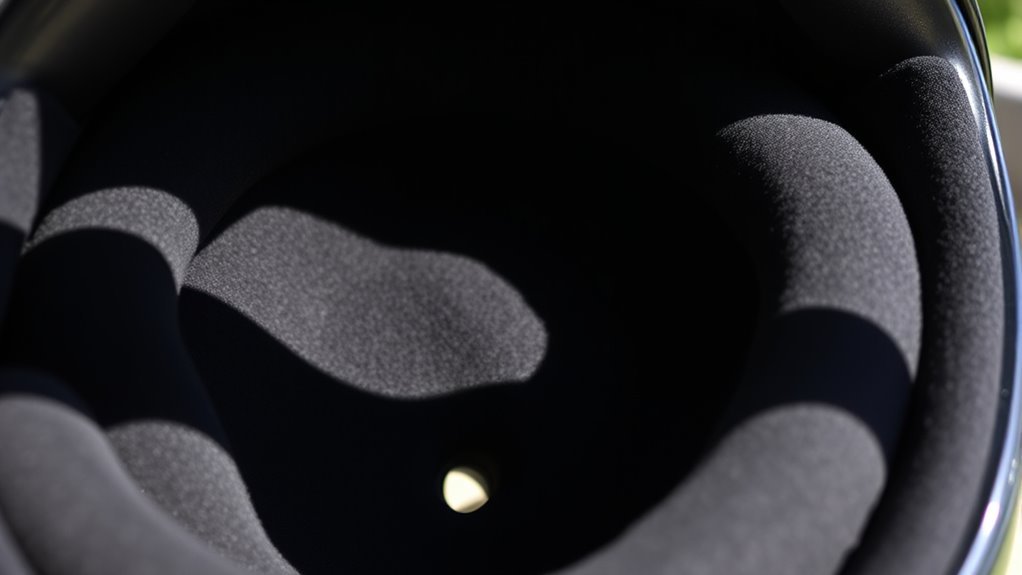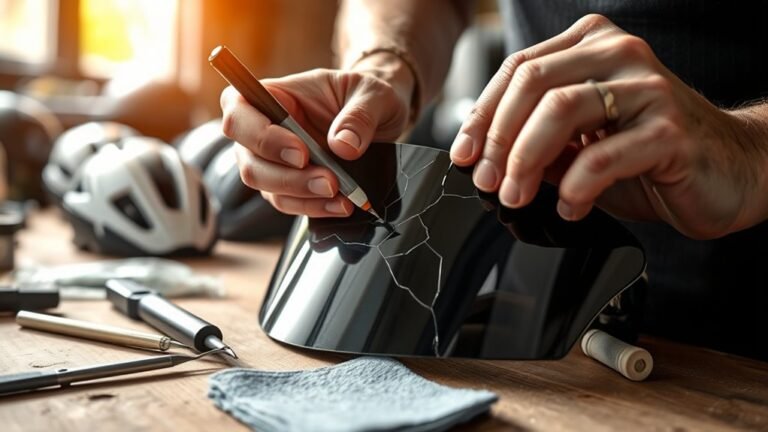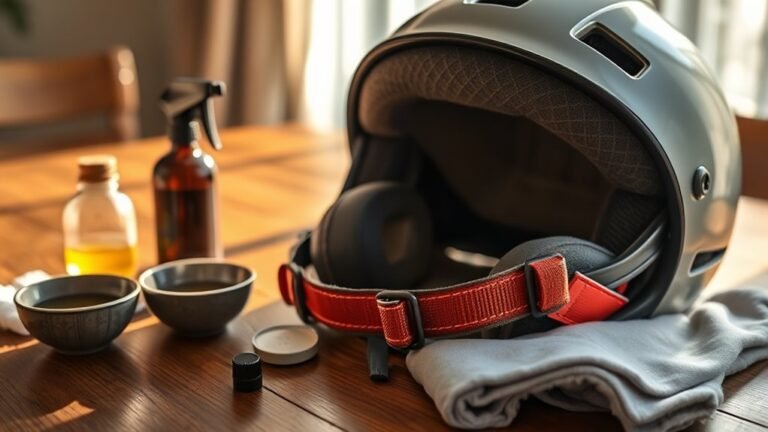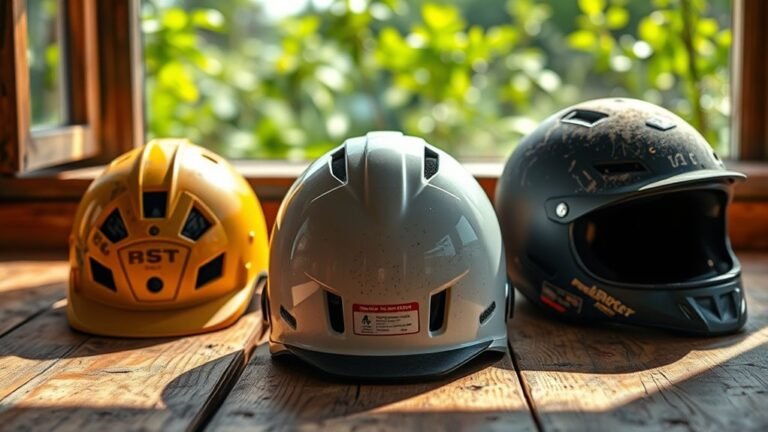How Helmet Padding Affects Comfort
Helmet padding affects comfort by influencing fit, moisture management, and cushioning. Thicker padding can enhance comfort but must balance density to avoid pressure points. Adjustability in padding design allows for a personalized fit, while moisture-wicking properties guarantee you stay dry during rides. Additionally, sound-dampening materials help create a quieter experience. Proper care and maintenance are essential for longevity. Understanding these factors can improve your overall riding experience, and there’s more to explore on this topic.
Understanding Helmet Padding Materials
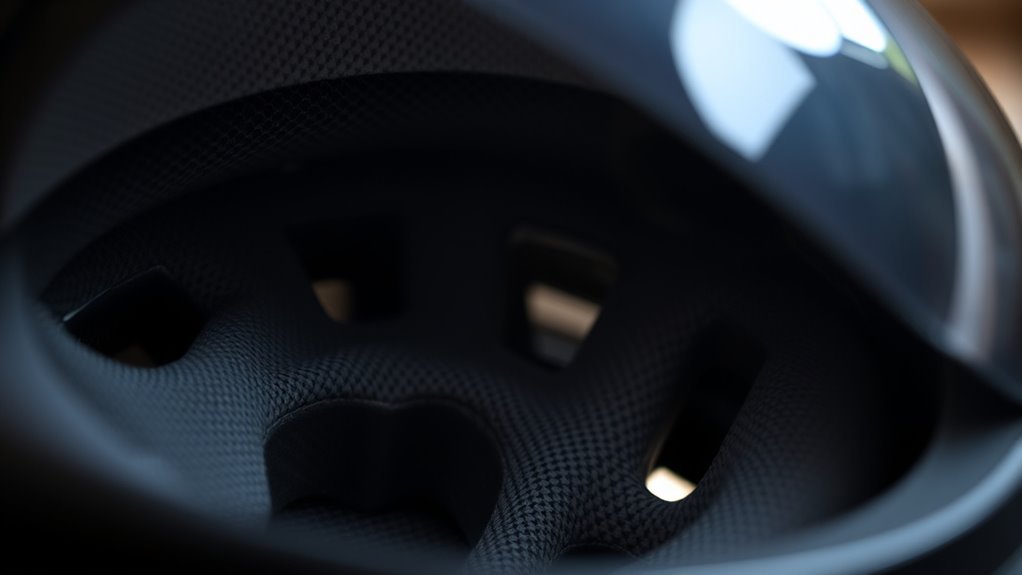
When you consider helmet comfort, understanding the materials used in padding is essential for making an informed choice. Various padding types, such as expanded polystyrene (EPS), foam, and gel, each offer unique benefits. EPS provides excellent shock absorption but can wear down over time, affecting material durability. Foam, often used in lower-cost helmets, may lack longevity but can be lightweight and comfortable. Gel padding is known for its premium comfort and adaptability, but it can be heavier and more expensive. The choice of padding material directly influences both comfort and safety, so evaluate your riding style and preferences. By understanding these materials, you can select a helmet that balances comfort, durability, and freedom during your rides.
The Role of Padding Thickness
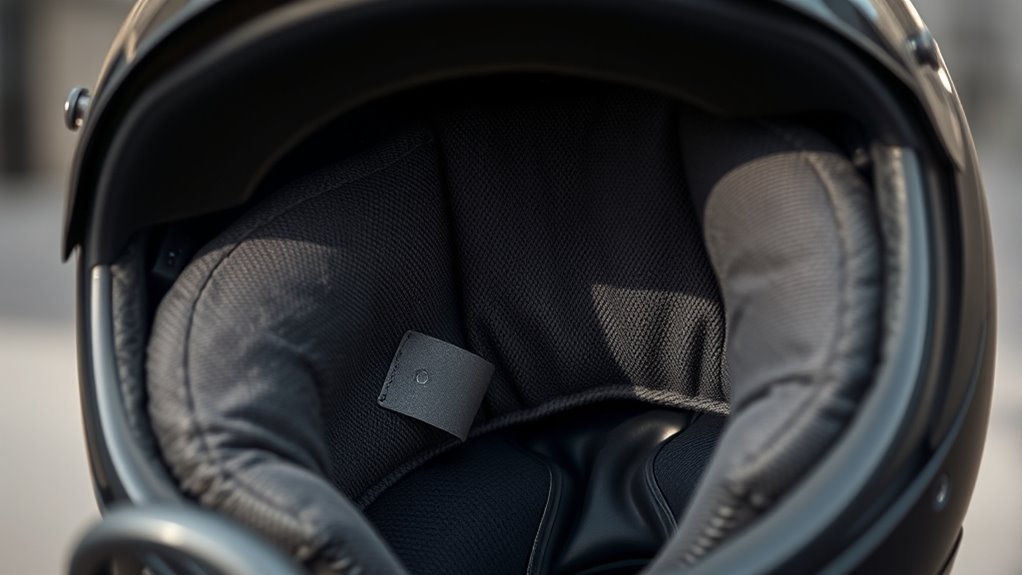
Padding thickness plays a crucial role in helmet comfort and performance. Thicker padding often offers greater cushioning effectiveness, which can enhance your overall experience during wear. However, it’s important to balance this with padding density; too thick might lead to excessive pressure points, while too thin can compromise comfort and safety.
When you choose a helmet, consider how the thickness interacts with the density of the padding material. A dense foam may provide adequate protection with less thickness, maintaining a comfortable fit without feeling bulky. Ultimately, the right combination of padding thickness and density can greatly impact how free and at ease you feel during your activities, allowing you to focus on your performance rather than discomfort.
Impact of Padding Design on Fit
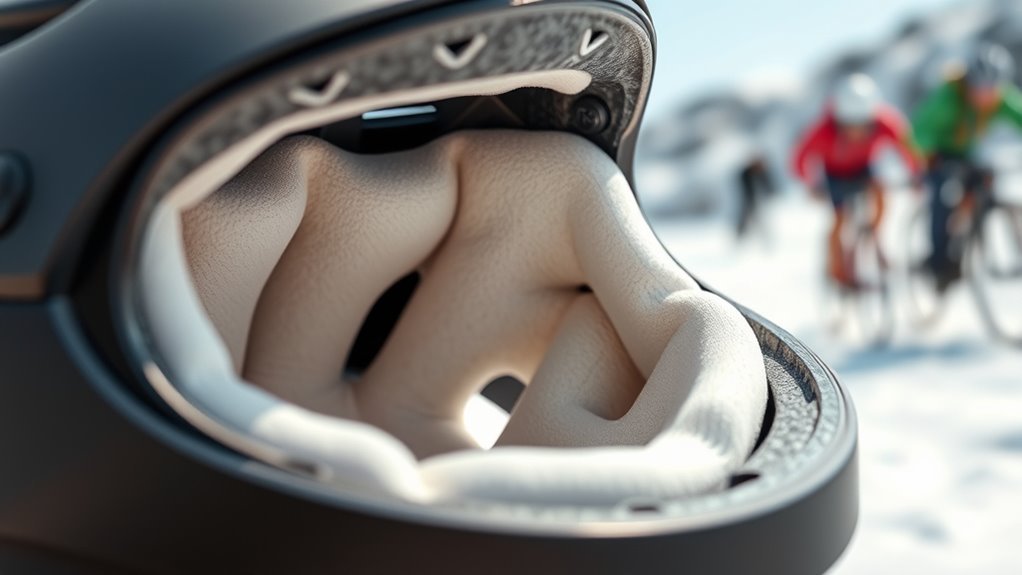
While the thickness and density of padding are important, the design of the padding itself can greatly influence how well a helmet fits. Effective padding shapes can accommodate various head contours, leading to enhanced comfort and safety. Here are three key aspects to evaluate:
The design of helmet padding significantly impacts fit, comfort, and safety by accommodating diverse head shapes.
- Curvature: Padding that follows the natural curvature of your head can reduce pressure points, allowing for longer wear times.
- Adjustable Layers: Multi-layer padding can provide fit adjustments, enabling you to customize the snugness of the helmet.
- Ventilation Design: Strategically placed padding shapes can improve airflow, reducing heat buildup during extended use.
A well-designed padding system not only enhances comfort but also guarantees the helmet remains securely in place during activities, giving you the freedom you desire.
Importance of Moisture-Wicking Properties
When it comes to helmet comfort, moisture-wicking properties play an essential role. Enhanced Dri-Fit technology not only reduces sweat accumulation but also helps maintain a fresher environment inside the helmet. This improvement in moisture management can markedly contribute to overall comfort and odor control during extended use.
Enhanced Dri-Fit Technology
Enhanced Dri-Fit technology plays an essential role in optimizing helmet comfort by effectively managing moisture. By incorporating this advanced moisture-wicking technology, you can experience significant dri fit benefits that enhance your performance and comfort. Here are three key aspects to evaluate:
- Improved Breathability: Dri-Fit materials allow air to flow, reducing heat buildup.
- Rapid Moisture Evaporation: This technology helps wick sweat away quickly, keeping you dry during intense activities.
- Enhanced Comfort: A drier environment reduces irritation and discomfort, allowing for longer wear.
With these features, enhanced Dri-Fit technology not only elevates your helmet experience but also empowers you to focus on your ride, free from distractions. Effective moisture management is crucial for those pursuing freedom in their adventures.
Reduced Sweat Accumulation
Moisture-wicking properties are vital for reducing sweat accumulation inside a helmet, as they directly impact your comfort and overall experience during strenuous activities. When you engage in high-intensity sports, maintaining ideal comfort levels is essential. Effective moisture-wicking materials facilitate sweat evaporation, drawing moisture away from your skin and allowing it to evaporate quickly. This process not only keeps you feeling cooler but also prevents the discomfort associated with a damp helmet lining. By minimizing sweat accumulation, these properties help maintain a balanced microclimate inside the helmet, which can enhance your focus and performance. Ultimately, investing in helmets with superior moisture-wicking capabilities can greatly elevate your riding experience, ensuring you stay comfortable and free to push your limits.
Improved Odor Control
One significant benefit of effective moisture-wicking properties is improved odor control, which can greatly enhance your overall comfort while wearing a helmet. This comfort is crucial, especially during long rides or strenuous activities. Here are three key aspects to contemplate:
- Odor Fighting Technologies: These advanced materials actively prevent the growth of odor-causing bacteria.
- Antimicrobial Treatments: Helmets with these treatments resist bacteria and fungi, ensuring you stay fresher longer.
- Moisture Management: By effectively pulling sweat away from your skin, these properties reduce wetness, which often leads to unpleasant smells.
Choosing a helmet with these features not only enhances comfort but also allows you to focus on your ride without distraction. It’s a small detail that makes a big difference.
Customization Options for Optimal Comfort
When considering helmet comfort, customization options play an essential role in achieving a perfect fit tailored to individual preferences. You can explore various padding adjustments that allow you to modify thickness and density, ensuring a personalized fit that enhances your experience. Many helmets come with removable liners, enabling you to easily swap out padding to match your comfort needs. Additionally, adjustable retention systems allow you to fine-tune the fit around your head, securing the helmet without excessive pressure. Some manufacturers even offer custom molds, creating padding that contours to your unique head shape. By taking advantage of these options, you can greatly enhance comfort during long rides, ensuring that your helmet feels like a natural extension of yourself.
How Padding Affects Noise Reduction
The type of padding in your helmet plays an essential role in noise reduction, as different sound dampening materials can greatly decrease external noise. Additionally, achieving a proper fit and seal around your head enhances the helmet’s ability to block out sound, further improving your auditory experience. Understanding these factors can help you make informed choices about your helmet’s padding for better overall performance.
Sound Dampening Materials
How effectively do sound dampening materials in helmet padding reduce noise? The choice of padding can considerably enhance your experience by providing better sound insulation and noise absorption. Here’s how these materials contribute to a quieter ride:
- Material Composition: Different materials, like foam or gel, vary in their ability to absorb sound waves, impacting overall noise levels.
- Layering Techniques: Multi-layer padding designs can enhance sound dampening by trapping noise between layers, effectively reducing external sounds.
- Custom Fit: Tailored padding molds to your head shape, creating a better seal that minimizes sound leakage.
Fit and Seal
While many factors contribute to noise reduction in helmets, the fit and seal created by padding play an important role in minimizing sound intrusion. A secure fit guarantees that the helmet sits snugly against your head, preventing gaps where noise can seep in. This is where fit adjustments become essential; they allow you to customize the helmet’s tightness to achieve ideal comfort and protection. Additionally, maintaining seal integrity is crucial for effective noise dampening. If the padding compresses or degrades over time, the helmet may lose its ability to block external sounds. Consequently, choosing high-quality padding that retains its shape and guaranteeing proper adjustments can greatly enhance your riding experience, granting you the freedom to focus on the journey ahead without unnecessary distractions.
Maintenance and Care of Helmet Padding
Maintaining and caring for helmet padding is essential for ensuring both comfort and safety during use. Neglecting this can lead to discomfort and even decreased protection. To keep your helmet padding in prime condition, consider these key practices:
Proper care of helmet padding is crucial for comfort and safety; neglecting it can compromise protection and lead to discomfort.
- Padding Cleaning: Regularly clean the padding with mild soap and water. Avoid harsh chemicals that can deteriorate the material.
- Drying: Allow the padding to air dry completely before reassembling it in the helmet. This prevents mold and unpleasant odors.
- Replacement Frequency: Check your padding for wear and tear every few months. Replace it if it’s compressed or damaged to maintain effective cushioning.
Choosing the Right Helmet for Your Riding Style
Which helmet best suits your riding style can greatly impact both your comfort and safety on the road. Understanding different helmet types is essential. For street riders, full-face helmets offer maximum protection and noise reduction, enhancing long-distance comfort. If you prefer cruising with the wind in your hair, an open-face helmet might align with your riding preferences, though it sacrifices some safety. Adventure riders often benefit from modular helmets, providing versatility for varied conditions. Off-road enthusiasts should consider dirt helmets, designed for ventilation and lightweight agility. Ultimately, assess your riding preferences carefully; the right helmet not only guarantees safety but also enhances your overall riding experience. Choose wisely, and your comfort will follow.
Frequently Asked Questions
How Often Should I Replace the Padding in My Helmet?
Think of your helmet padding as the clouds cushioning your head during a storm. To keep that comfort intact, you should replace the padding every 2 to 3 years, depending on usage and wear. Regular maintenance tips include checking for tears, odors, or loss of shape. If you notice any signs of deterioration, it’s time to say goodbye. Prioritizing a fresh, supportive layer enhances your freedom to ride with confidence and safety.
Can Helmet Padding Cause Skin Irritation or Allergies?
Yes, helmet padding can cause skin irritation or allergies, especially if you’re sensitive to certain padding materials. Common allergy symptoms include redness, itching, and rashes where the helmet contacts your skin. It’s essential to know what materials are used in your helmet’s padding; synthetic materials often trigger reactions more than natural ones. If you experience any symptoms, consider switching to a helmet with hypoallergenic padding for a more comfortable ride.
Does Padding Weight Affect Overall Helmet Comfort?
Padding weight can greatly affect overall helmet comfort. Heavier padding may feel like an anchor, pulling down on your head, while lighter materials can create a sensation of weightlessness. The density of the padding also plays a role; denser materials often provide better shock absorption but can feel bulkier. Balancing padding weight and density guarantees you enjoy freedom of movement without sacrificing protection, making your ride both comfortable and secure.
Are There Specific Paddings for Different Weather Conditions?
Yes, there are specific paddings designed for different weather conditions. You’ll find weather-specific materials that enhance breathability in hot climates, allowing moisture to escape, while insulating paddings work to retain warmth in colder conditions. Temperature regulation techniques, like using gel-infused foam or moisture-wicking fabrics, can greatly improve comfort. Choosing the right padding for the environment can make all the difference in your riding experience, ensuring you stay comfortable regardless of the weather.
How Do I Know if My Helmet Padding Fits Correctly?
To know if your helmet padding fits correctly, start by checking the helmet size; it should sit snugly without causing discomfort. Adjust the padding for a personalized fit, ensuring it evenly distributes pressure around your head. When you shake your head, the helmet shouldn’t move considerably. You should feel no pressure points. If it feels loose or overly tight, consider replacing the padding or adjusting the straps for ideal comfort and security.
